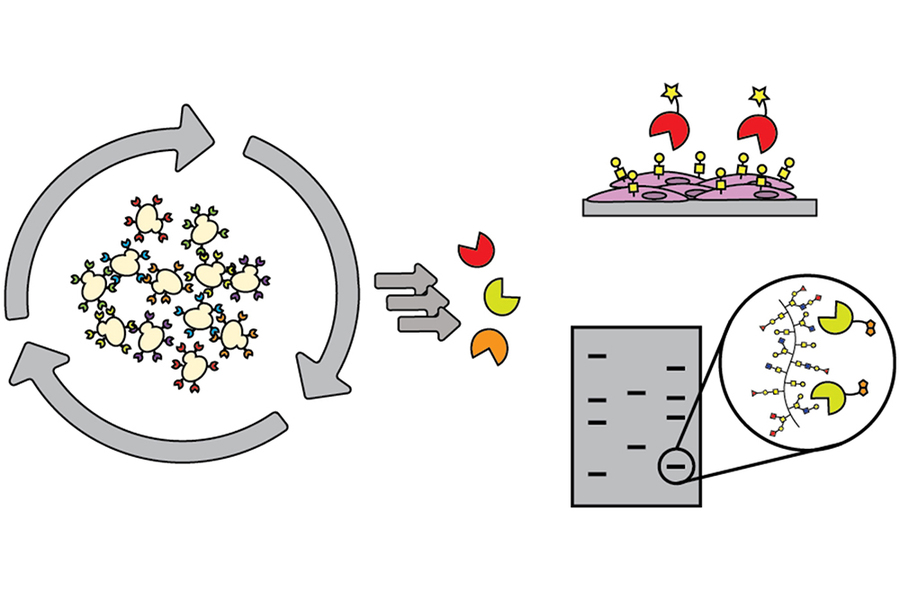搜索结果: 1-15 共查到“生物学 Binding”相关记录72条 . 查询时间(0.14 秒)

Adjusting retinol-binding protein concentrations for inflammation: Biomarkers Reflecting Inflammation and Nutritional Determinants of Anemia (BRINDA) project
anemia inflammation meta-analysis nutritional assessment retinol-binding protein vitamin A deficiency
2018/11/15
Background: The accurate estimation of the prevalence of vitamin A deficiency (VAD) is important in planning and implementing interventions. Retinol-binding protein (RBP) is often used in population s...
Study reveals the multitasking secrets of an RNA-binding protein
multitasking secrets RNA-binding protein
2017/4/27
Researchers from Princeton University and the National Institute of Environmental Health Sciences have discovered how a fruit fly protein binds and regulates two different types of RNA target sequence...
Structural and Spectroscopic Analysis of the Kinase Inhibitor Bosutinib and an Isomer of Bosutinib Binding to the Abl Tyrosine Kinase Domain
Humans Escherichia coli Benzamides Quinolines Nitriles Aniline Compounds Piperazines Pyrimidines Thiazoles Recombinant Proteins
2016/5/25
Chronic myeloid leukemia (CML) is caused by the kinase activity of the BCR-Abl fusion protein. The Abl inhibitors imatinib, nilotinib and dasatinib are currently used to treat CML, but resistance to t...
Hydrogen Bonding Modulates Binding of Exogenous Ligands in a Myoglobin Proximal Cavity Mutant
Alanine Amino Acid Substitution Animals Binding Sites Glycine Histidine Hydrogen Bonding Imidazoles Ligands Macromolecular Substances Metmyoglobin Models, Chemical Mutagenesis, Insertional Myoglobin Nitric Oxide Nuclear Magnetic Resonance,Biomolecular Protons Serine Threonine Whales
2016/5/23
In the sperm whale myoglobin mutant H93G, the proximal histidine is replaced by glycine, leaving a cavity in which exogenous imidazole can bind and ligate the heme iron (Barrick, D. (1994) Biochemistr...
Trans Effects in Nitric Oxide Binding to Myoglobin Cavity Mutant H93G
biology and medicine, basic studies nitric oxide biochemistry heme histidine imidazoles ligands mutants myoglobin proteins
2016/5/23
When nitric oxide (NO) binds to heme proteins, it exerts a repulsive trans effect on the proximal ligand, resulting in weakening or rupture of the proximal ligand-iron bond. The general question of wh...
Modulation of Protein Function by Exogenous Ligands in Protein Cavities:CO Binding to a Myoglobin Cavity Mutant Containing Unnatural Proximal Ligands
Animals Binding Sites Carbon Monoxide Cloning, Molecular Escherichia coli Heme Kinetics Ligands Magnetic Resonance Spectroscopy Mutagenesis, Site-Directed Myoglobin Myoglobin Point Mutation Protein Conformation ecombinant Proteins Recombinant Proteins Spectroscopy,Fourier Transform Infrared Valine Whales
2016/5/23
A variety of heterocyclic ligands can be exchanged into the proximal cavity of sperm whale myoglobin mutant H93G, providing a simple method for introduction of the equivalent of unnatural amino acid s...
Determination of the Carbon Monoxide Binding Constants of Myoglobin Mutants:Comparison of Kinetic and Equilibrium Methods
Binding Sites Carbon Monoxide Humans Kinetics Mutagenesis, Site-Directed Mutation Myoglobin Myoglobin Myoglobin Nitric Oxide Photolysis Protein Conformation Spectroscopy, Fourier Transform Infrared Structure-Activity Relationship
2016/5/23
The carbon monoxide (CO) binding constants of human myoglobin (Mb) and several single-site mutants have been determined using two different methods. In the kinetic method, which is commonly used for t...
Anatomy and Dynamics of a Ligand-Binding Pathway in Myoglobin:The Roles of Residues 45,60,64 and 68
Humans Carbon Monoxide Myoglobin Recombinant Proteins Ligands Spectrum Analysis Protein Binding Kinetics Mutation Thermodynamics
2016/5/23
In order for diatomic ligands to enter and exit myoglobin, there must be substantial displacements of amino acid side chains from their positions in the static X-ray structure. One pathway, involving ...
Discovery of New Ligand Binding Pathways in Myoglobin by Random Mutagenesis
Animals Whales Myoglobin Ligands Genetic Techniques Mutagenesis Binding Sites Amino Acid Sequence Protein Conformation Structure-Activity Relationship
2016/5/23
A random library of single amino acid mutants of myoglobin was generated using a highly efficient, single-base-misincorporation random mutagenesis method to discover new ligand-binding pathways in myo...
Perturbations of the Distal Heme Pocket in Human Myoglobin Mutants Probed by Infrared Spectroscopy of Bound CO:Correlation with Ligand Binding Kinetics
Distal Heme Pocket Human Myoglobin Mutants Probed Infrared Spectroscopy Bound CO:Correlation Ligand Binding Kinetics
2016/5/23
The infrared spectra of CO bound to human myoglobin and myoglobin mutants at positions His-64, Val-68, Asp-60, and Lys-45 on the distal side have been measured between 100 and 300 K. Large differences...
Mapping, Tissue Distribution and Polymorphism of Porcine Retinol Binding Protein Genes (RBP5 and RBP7)
Retinol Binding Protein Complete Coding Sequence Porcine Reverse Transcriptase Polymerase Chain Reaction Single Nucleotide Polymorphism Genotype
2016/4/28
The retinoids (vitamin A and its derivatives) play a critical role in vision, growth, reproduction, cell differentiation and embryonic development. Using the IMpRH panel, porcine cellular retinol bind...
Polymorphism of Insulin-like Growth Factor Binding Protein-4 Gene in 17 Pig Breeds and Its Relationship with Growth Traits
IGFBP-4 Gene Performance Traits Swine PCR-SSCP
2016/4/26
Insulin-like growth factor binding protein-4 (IGFBP-4) is a member of the IGF super family, and regulates the action of IGFs. The polymorphism of porcine IGFBP-4 gene in 17 pig breeds (total n = 570) ...
Abstract
Timothy E. Breen Ph.D.
A DATABASE FOR NUCLEAR RECEPTOR DNA BINDING SITES
A database has been developed for nuclear receptor DNA binding sites and the corresponding nuclear receptor DNA ...
Protein function prediction by integrating sequence, structure and binding affinity information
protein function binding affinity information
2015/5/26
Proteins are nano-machines that work inside every living organism. Functional disruption of one or several proteins is the cause for many diseases. However, the functions for most proteins are yet to ...


